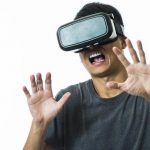 Virtual reality as a healthcare tool is something I’ve touched on a bit recently. For instance, I wrote recently about an interesting application of virtual reality to help patients rehabilitate after an injury. Immersive Rehab aim to help these people by offering both neurological and physical rehab in a virtual environment. Users perform the same kind of movements they would attempt in physical rehab, but they are grabbing and interacting with items virtually. The idea is that they trick the brain into thinking they are engaging with real objects, and thus make important gains in their mobility.
Virtual reality as a healthcare tool is something I’ve touched on a bit recently. For instance, I wrote recently about an interesting application of virtual reality to help patients rehabilitate after an injury. Immersive Rehab aim to help these people by offering both neurological and physical rehab in a virtual environment. Users perform the same kind of movements they would attempt in physical rehab, but they are grabbing and interacting with items virtually. The idea is that they trick the brain into thinking they are engaging with real objects, and thus make important gains in their mobility.
There has also been a deployment of VR to help give terminally ill patients a virtual trip down memory lane. Users are transported to a familiar location for them, whereby they can interact with family and friends.
Or you’ve got the project from researchers at the University of North Carolina at Chapel Hill and North Carolina State University to examine the use of VR in reducing falls among the elderly, or indeed the project by researchers from Penn State who are using VR to provide both mental and physical therapy programs.
VR and mental health
Continuing this theme is a recent paper from the University of Georgia that explores the growing use of VR in mental health.
“Virtual reality is potentially a powerful tool for the psychiatric community,” the authors say. “It allows providers to create computer-generated environments in a controlled setting, which can be used to create a sense of presence and immersion in the feared environment for individuals suffering from anxiety disorders.”
The paper examines the current state of VR in psychiatric treatment, with the most common current application being in the treatment of anxiety disorders. For instance, users might be exposed to frightening situations. VR is capable of recreating exposures that would be either costly or impractical to recreate in real life. Therapists can also control the dosage of each exposure too.
The examination of such applications suggests that they have clear benefits to patients. For instance, studies of flight phobia have reported significant and lasting reductions in flight-related anxiety. Patients report satisfaction with VR-based therapy, and in some cases find it more acceptable than traditional therapy.
Whilst the initial results do appear promising, not just in anxiety related areas but also in areas such as addiction and eating disorders, the number of participants in studies is generally low, and it’s therefore difficult to read too much into their use in practice. It’s an area that is ripe for growth however.
“With the cost of head-mounted displays coming down and smaller smartphone applications being developed, it is likely that virtual reality applications will proliferate,” the authors say. “It will be important that these are treated as tools and therapists are properly trained in their applications.”
For sometime it seemed like VR would be little more than a gimmick, but it seems to be finding a niche in healthcare, and it will be fascinating to see how this niche evolves.